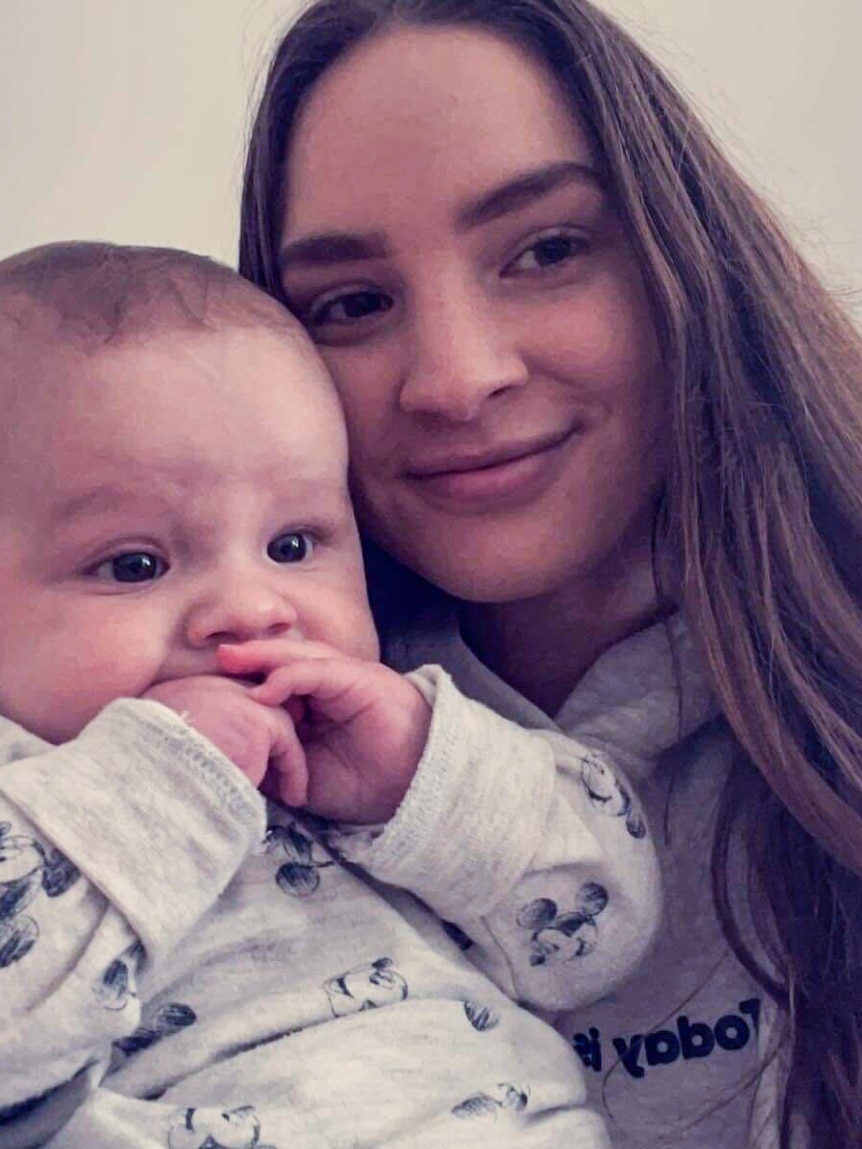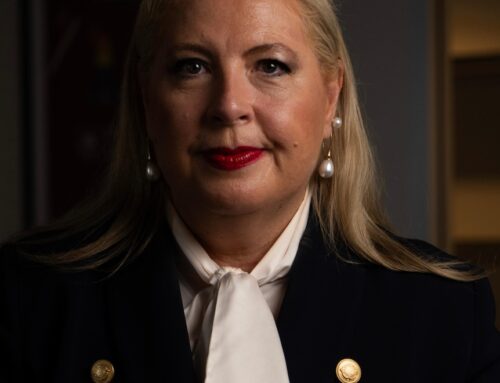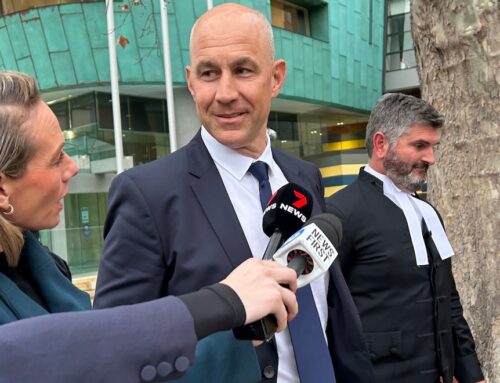Single mother Tilly Eastwood says the worst part of being priced out of the rental market isn’t living in a garage with her three children. It isn’t the absence of windows for light or fresh air. It’s not even the 150-plus failed rental applications.
It’s the gnawing feeling that she’s letting down her kids.
“I started applying probably about September, so it’s been about a year now. I even applied to ones that I didn’t want to live in and still got rejected,” she says.
“I’ve had moments where I’ve just applied for a heap, and then … had to give up for a while because it’s kind of like a kick in the face, getting that many rejections and the feeling like you can’t get a place to support your own kids.”
Her seaside home town of Redcliffe, in Queensland’s Moreton Bay North, is described on the region’s tourism website as “the perfect destination if you want to escape the rush of inner Brisbane”.
Tilly Eastwood in the garage where she lives with her children. ABC Brisbane: Mark Leonardi
The median asking rent for houses in the region has leapt by more than 33 per cent since 2020, making it one of the top 12 areas nationwide that have seen the sharpest increases in rent since the start of the pandemic.
In Scarborough, the suburb the family currently calls home, house rents have surged by 42 per cent.
“I’ve had some days where I’ve just kind of broken down and cut off. I deal with my own mental illnesses, so it takes a toll on that,” the hospitality worker says.
Tilly has been living in a friend’s garage with her three children aged between 4 and 12, and their pet bearded lizard, Baby, since May, when the lease on their south Brisbane rental ended.
Tilly says wants to stay in Redcliffe so the children can be close to their father and school, and she can be close to work and the support of friends and family.
“We were all by ourselves [in south Brisbane] and my mental health wasn’t the best,” she says.
In the garage, blue plastic tarpaulins separate their corner from the rest of the space, which her friend uses to store a couch, dining table and other furniture.
Rubber camping mats and rugs provide some protection from the hard concrete floor. A borrowed fan borrowed whirrs constantly, providing the only ventilation.
“I’ve got two Kmart racks with my clothing and my shoes, then I’ve got another rack with the girls’ clothes all folded and hanging up. And then my son’s stuff is in boxes underneath the bunk beds,” the 31-year-old says.
“Any noise that I make downstairs travels all the way upstairs, so I’m always trying to keep my kids quiet … We don’t use the kitchen. We just use what we’ve got downstairs so we stay out of my friend’s way.”
Tilly shares the queen bed with her younger daughter, while the two older children sleep in the bunk bed. The beds are so close they can reach out while they’re lying down and touch fingers.
“I’m one of the lucky ones. She’s my best friend, so as soon as she found out, she said I can stay here until I [find a place],” Tilly says.
“I’ve never ever experienced this much issue trying to find a place. Ever. And I’ve been renting for over 11 years.”
With an income of roughly $1,100 a week, Tilly is among thousands of low-income earners facing desperate situations as Australia’s rental prices soar to new heights.
In a sign of how widespread the nation’s rental crisis has become, advertised house rents have hit record highs this year in 85 per cent of suburbs with reliable data, an ABC analysis has revealed.
The figure is the highest in two decades of data from property portal Domain and a massive jump compared to 2020, when median advertised house rents reached record highs in just over half (51 per cent) of suburbs.
The data, supplied exclusively to the ABC, tracks median asking rents in nearly 4,000 Australian suburbs, roughly one-third outside capital cities, from January 2002 to August 2022.
The figures are compiled from Domain’s own websites as well as property market data licensed from third parties.
Nicola Powell, chief of research and economics at Domain, describes current rental market conditions as “extraordinary”.
“Australia-wide, as well as every single capital city, is deemed a landlord’s market,” she says.
Vacancy rates in Sydney, Brisbane and Perth hit record lows in August 2022, according to the data. In Melbourne, the vacancy rate fell for an eighth consecutive month and is now only 0.2 percentage points off its record low.
The vacancy rate is an estimate of the percentage of rental stock that has been on the market for longer than 21 days.
“In the June quarter, the combined capital cities recorded the longest stretch of continuous rental growth on record and the biggest yearly jump in rent since 2007,” Dr Powell says.
“We saw house rents across the combined capitals notch a fifth consecutive quarter of increasing rents. For units, it was the fourth consecutive quarter.”
Advertised rents describe market conditions for people seeking a new lease, rather than the prices paid by the 31 per cent of Australian households that rent, many of whom are paying lower prices locked in at the beginning of their tenancy.
Rapid rises in asking rent affect vulnerable Australians most because they move more often and are in more precarious housing arrangements, says Brendan Coates, economic policy program director at the think-tank the Grattan Institute.
However, trends in advertised rents eventually flow through to actual rents.
“Advertised rents are an early predictor of what happens across the whole rental market over time,” he warns.
“The big worry is that advertised rents rising so quickly suggests that, for a lot of people, rents are going to get more expensive in the next couple of years, not cheaper.”
Where rents have risen fastest
In the eight months it took Mikayla Roberts to find a new home to rent in Mandurah, Western Australia, she viewed more than 600 properties, moved three times and gave birth to a baby boy.
“We were applying for up to, I would say, probably 20 rentals per week and just constantly getting rejected. We ended up having to rehome our animals as well, which was very sad,” the 23-year-old says.
“I was maybe five months-or-so pregnant when we started looking. We knew it was going to be hard. Obviously, we didn’t expect it to be as hard as it was.”
In the two years since the pandemic began in 2020, asking rents have risen by 35 per cent in Coodanup and up to 50 per cent in other parts of Mandurah, which is 6th among Australia’s worst-ranked areas for increased asking rent.
Mikayla and her partner were forced to move when the owner of their home in the Mandurah suburb of Coodanup decided to sell.
They’d been paying $300 a week and hoped to find something in a similar price range. They then teamed up with a friend and increased their budget to $400 a week. It was not enough.
“It was absolutely crazy … We even saw quite a few [rentals] where the back fences were missing, there was damage all through the house and you were still expected to pay anywhere pretty much from $350 up to $500,” the employment consultant says.
“We ended up looking at literally anything, even up to an hour-and-a-half away … And we set a new budget of $550 per week because we just needed a rental.”
One of the toughest times was when their son Kyle was born and her partner Jayme had to live “out bush” in his car for a few weeks with their pets.
“All I wanted was for us to be together … especially because we are both new parents,” Mikayla says.
“We had moments where we just didn’t want to try anymore, but obviously that wasn’t an option either … With my son, we had to push through and get a roof over his head.”
When the trio were eventually approved for a lease, the house was half an hour north of Mandurah, in Perth’s southwest, and cost $420 a week – 40 per cent more than their previous rental.
Nationwide, the median asking rent has climbed by nearly 24 per cent for houses and 12 per cent for units since the start of the pandemic in March 2020.
However, these figures hide dramatic differences between cities and regions, especially in our most populous states.
In NSW and Victoria, the pandemic saw house rents in regional areas overtake capital city unit rents for the first time. In Victoria, they remain neck-and-neck, while in NSW, capital city unit rents have just crept past regional asking rents for houses.
In Queensland, regional asking rents are now more expensive than in Brisbane, for both houses and units – a trend not seen in units since 2008 or in houses since 2013.
Domain’s Dr Powell says “roaring” interstate migration, which became the key driver of the housing market when the international border closed, has sent Queensland’s asking rents through the roof.
“Brisbane and south-east Queensland as a whole have seen some phenomenal rates of demand… and particularly so from Sydney and Melbourne. It was people escaping Melbourne’s lockdowns, it was people exiting Sydney in search of a more affordable lifestyle.”
Moreton Bay resident Tamira Shields was separated from her mother, for whom she cares full-time, when their landlord decided to sell and they couldn’t find a new home.
Tamira’s mother, 58, has severe emphysema and lives on home oxygen. When Tamira first spoke to the ABC, she was staying with her aunt and her mother was living with a friend.
“It’s been pretty traumatising for all of us,” she says.
“I don’t have a [driving] licence or anything like that, so it’s really hard for me to care for my mum when she’s not even under the same roof … And where she’s living, she doesn’t have the care that she’s supposed to.”
Across greater Brisbane, advertised rents for houses have soared 35 per cent since mid-2020, compared to 25 per cent in Sydney and 9 per cent in Melbourne.
The trio have applied for “hundreds” of properties and Tamira has spent months “jumping from home to home” with her fiance and two-month-old son.
“I’ve gone out of my way to sign waivers to say that I will apply for a house without viewing it first. We’re even offering up to $60 a week extra on what they’re advertising and still getting nothing,” she says.
“Honestly, it’s just depressing … it does tend to make you feel a little bit worthless,” the 19-year-old says.
Four months after beginning their search and a week after speaking to the ABC, the family managed to secure a lease in Strathpine, in Moreton Bay South. They offered $10 a week on top of the asking price but were approved at the advertised price.
Tamira says they had no idea it would take so long, especially with her mother’s strong rental record. “My mum had 21 years of rental history at the one address and she paid rent every week, on time, the full amount. She was a great tenant. My partner makes great money … [but] within 24 hours after each application we get rejected.”
Red Cross regional operations manager Charlene Keller says she’s not surprised families like Tamira’s are struggling to find a new rental.
Ms Keller leads a program in Toowoomba, in south-east Queensland, which is designed to help people maintain their tenancies.
But she says the need has become so urgent over the past two years that her team has had to adapt to working as a crisis accommodation service.
She says the current crisis is the first time her team has seen professionals and working couples with good rental histories struggling alongside low-income groups to secure a lease.
In some cases, these groups compete against vulnerable people, some of whom are choosing between unsafe domestic situations or living on the street.
“It’s across the board,” she says.
“I haven’t experienced anything like this before. This is definitely an emergency for our community.”
‘A needle in a haystack’
Even before the pandemic, rents were rising faster in the regions than in many capital cities. When the pandemic hit in 2020, it supercharged this trend, sending capital city rents plummeting and regional rents skyrocketing.
Commuting towns within a couple of hours of the city, coastal regions and so-called lifestyle areas have seen some of the steepest increases in asking rents.
Among them are the Gold Coast, Wide Bay and Sunshine Coast in Queensland; Richmond-Tweed, Coffs Harbour and the Central Coast in NSW; Bunbury and Mandurah in WA; and LaTrobe-Gippsland in Victoria.
Allowing, or in some instances, compelling, a large proportion of the population to work from home “opened up where we can reside … [creating] a renaissance in outer suburbia and increased demand in regional Australia,” Dr Powell says.
“COVID created perhaps the greatest social and lifestyle shift that Australia has seen since World War II,” she says.
“It was this race for space, and people were willing to pay that premium. People used their homes differently. They wanted that additional space, that spare bedroom, that ‘Zoom Room’ or office.
“In some regional markets … it’s like trying to find a needle in the haystack if you are seeking a new rental lease,” Dr Powell says.
In 2021, the second year of the pandemic, house rents in more than 85 per cent of regional suburbs covered in the dataset hit record highs, roughly twice the figure for capital cities.
And capital city rents are still catching up.
Figures from August 2022 show that, across the nation, house asking rents have surged by at least 25 per cent since the pandemic in more than 1,000 suburbs.
These are almost twice as likely to be in regional areas, where just over 40 per cent of suburbs have jumped this much, compared to 24 per cent in capital cities.
This search for space, combined with an exodus of international students and overseas migrants when Australia’s border closed, also led to a record gap between house and unit rents.
Where to from here
Most experts agree that what is desperately needed is a significant injection of rental housing stock, which won’t happen quickly.
“Conditions do remain quite bleak for tenants,” Dr Powell says.
“Overseas migration is still recovering and isn’t expected to fully recover until 2024-25, so there is going to be that drip feed … that will place particular demand on the rental market.”
But there is at least one thing policy makers could do that would ease the pain for the most vulnerable people.
“In the very short term, the best thing that we could do is put more income in the hands of low income renters, so they could compete in the rental market,” Grattan’s Coates says.
“Rent assistance hasn’t risen in line with rents over the course of the last few decades, and it certainly hasn’t risen as fast as the rents being paid by low income Australians.”
He recommends raising the rate of rent assistance – paid by the Commonwealth government to low income earners in the private rental market – by at least 40 per cent.
Kath Hulse, professor of Housing Studies at Swinburne University of Technology, says part of the problem is that soaring purchase prices are compelling more Australians to rent for longer because they’re locked out of the housing market.
“So a lot of the housing that could potentially be affordable to people on low to moderate incomes is actually occupied by households on higher incomes,” Professor Hulse says.
“[These households] would like to buy but they don’t want to spend a lot of money on rent because they’re trying to save a deposit. So they ‘rent down’.”
Professor Gurran says private sector landlords should be asked to play a bigger role. For example, to provide more secure leases, moderate rental increases, or participate in rent social and affordable housing programs.
“We are spending a lot on the private rental sector in the form of negative gearing … if we’re prepared to spend $30 billion a year on subsidising private rental landlords, we should be asking what we’re getting out of that massive public subsidy.”
Back in Redcliffe, Tilly has begun working two jobs to boost her income and is considering sharing with a friend in the hope of increasing the family’s chances of securing a lease.
“I’ve heard if you’ve got two incomes, they’ll look at you more,” she says.
“My kids need their own rooms. I need my own room … I’m willing to try anything at the moment.”
Credits
Data and reporting: Inga Ting
Development: Katia Shatoba
Design: Alex Palmer
Notes about this story
- Data analysed in this story is skewed to suburbs with active rental markets; it does not include every suburb in Australia
- Data excludes suburbs with fewer than five years of data, years with fewer than 10 records and median weekly asking prices less than $60 or more than $5,000
- Estimates of rental stock used to calculate vacancy rates are derived from census data and adjusted to to reflect current levels
- Figures are not adjusted for inflation
Posted , updated





